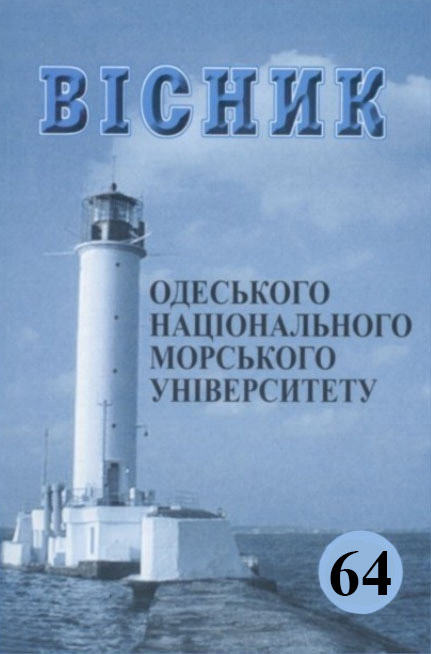Substantiation of outlook of train car-passenger ferries for the Caspian sea
Main Article Content
Abstract
The analysis of necessity of creation of new train carpassenger ferries for the Caspian Sea has been carried out. The cargo base for vessels of the Caspian region is determined by the special geographical transit position of the great lake-sea and the needs of the Caspian countries – Azerbaijan, Russia, Kazakhstan, Iran, Turkmenistan and some neighboring countries – Georgia, Armenia, Turkey, Uzbekistan, as well as India, Afghanistan, Pakistan. The concept has been substantiated and the main characteristics of the new cargo-passenger ferry have been determined. Advantages of the new CNF18C ferry comparing with existing ones: general capacity for T-1 railway wagons (length between coupling gauges of 12020 mm) is 56 units (not more than 54 at existing vessels); rails are placed below deck lever; open deck accelerates and facilitates loading/unloading processes and also positively influences onto shipping safety; availability of the side ramp for loading/unloading vehicles onto berths provides work not only at usual railway berths but also at ordinary dry cargo berths of sufficient length; cargo hold’s height (5400 mm) allows to transport high wagons in the holds (existing ferries have hold of 5000 mm height); cargo elevator’s length of 25 m provides two railway tracks loading/unloading of railway wagons and Ro-Ro cargoes of 188 t total weight from upper deck to lower one, including 11-935F platforms of 19620 mm length with 3 TEU (existing ferries have cargo elevator of 14540 mm length and 170 t lifting capacity); 100 passengers may be placed and transported onboard the vessel. Simultaneously transportation of passengers and dangerous cargoes is foreseen according to dangerous goods transportation regulations.
Article Details
References
2. Alchudzhan G.A., Kostenko M.M. (1975). Rezul’taty issledovaniya osnovnykh tekhniko-ekspluatatsionnykh kharakteristik novogo zheleznodorozhnogo paroma dlya Kaspiyskogo morya [Results of the study of the main technical and operational characteristics of the new railway ferry for the Caspian Sea]. − Trudy TSNIIMF: Perspektivnyye tipy morskikh sudov (Proceedings of CSRDIMF: Perspective types of sea vessels). Vol. 198, 54-65 (in Russian).
3. Egorov, G.V. (2003). Prochnostnyye problemy proyektirovaniya zheleznodorozhnykh paromov dlya Kaspiya [Strength problems of design of train ferries for the Caspian Sea]. – Trudy NTK po SMK pamyati akad. Yu.A. Shimanskogo (Proceedings of STC on structural design of ships in memory of acad. Yu.A. Shimanskiy), 18-19 (in Russian).
4. Egorov, G.V., Ilnytskiy, I.A. (2008). Mnogotselevyye sukhogruznyye suda dedveytom 7000 t dlya Kaspiyskogo morya [Multipurpose dry-cargo vessels of 7000 DWT for the Caspian Sea]. Visnuk ONMU (Reporter of Odessa National Maritime University), 24, 137-164 (in Russian). ВІСНИК ОДЕСЬКОГО НАЦІОНАЛЬНОГО МОРСЬКОГО УНІВЕРСИТЕТУ № 1 (64), 2021 HERALD OF THE ODESSA NATIONAL MARITIME UNIVERSITY № 1 (64), 2021 31
5. Egorov, G.V., Ilnytskiy, I.A. (2015). Kontsepty sovremennykh zheleznodorozhnykh gruzopassazhirskikh paromov dlya Kaspiyskogo morya [Concepts of modern train cargo-passenger ferries for the Caspian Sea]. − Materialy Vseukrainskoy NTK s mezhd. uch. «Sovremennyye tekhnologii proyektirovaniya, stroitel’stva, eksplu-atatsii i remonta sudov, morskikh tekhnicheskikh sredstv i inzhenernykh sooruzheniy» (Proceedings of the All-Ukrainian STC with int. part. «Modern technologies for the design, construction, operation and repair of ships, marine technical equipment and engineering structures»), 30-31 (in Russian).
6. Egorov, G.V., Anisimov, K.O. (2020). Analiz i perspektivy mezhdunarodnykh zheleznodorozhnykh i avtomobil’nykh paromnykh liniy Kaspiyskogo basseyna [Analysis and prospects of international train and car ferry lines of the Caspian basin]. − Trudy Krylovskogo gosudarstvennogo nauchnogo tsentra (Proceedings of KSRC). Special Vol. 2, 199-204 (in Russian).
7. Egorov, G.V., Egorov, A.G. (2020). Novyy kaspiyskiy gruzovoy flot [New Caspian cargo fleet]. − Materialy XI mezhdun. НТК «Innovatsii v sudostroyenii i okeanotekhnike», posvyashchennoy 100- letiyu Natsional’nogo universiteta korablestroyeniya (Proceedings of the XI International STC «Innovations in shipbuilding and ocean engineering» dedicated to the 100th anniversary of the National University of Shipbuilding), 83-85 (in Russian).
8. Ilnytskiy, K.A. (2016). Kaspiyskaya tranzitnaya al’ternativa [Caspi-an transit alternative]. Porty Ukrainy (Ukrainian ports), 7 (159), 28-30 (in Russian).
9. Demeshko, G.F., Rumin, S.N., Boytsun, I.I., Moreynis, F.A. (2015). Paromnyye perevozki na gruzovykh liniyakh akvatorii Kaspiyskogo morya [Ferry transportation on cargo lines of the Caspian Sea]. − Trudy KGNTS (Proceedings of KSRC). Vol. 89.2 (373.2), 161-175 (in Russian).
10. (2006). Transportnyye svyazi Yevropa-Aziya [Transport links Europe-Asia]. − ISBN 92-821-0381-1. −YEKMT (EKMT), 82 p.
11. Website of the President of the Republic of Azerbaijan. [Electronic source]. − Retrieved from: https://ru.president.az/articles/32878 (access date 30.04.2021).
12. Website of the President of the Republic of Azerbaijan. [Electronic source]. − Retrieved from: https://ru.president.az/articles/50762 (access date 30.04.2021).
